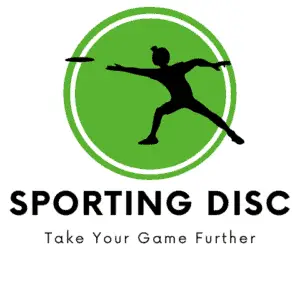If you’re new to disc golf, one rule that you might not be aware of is the foot fault.
What can be more confusing, is that the rule changes depending on where you’re throwing your disc from.
It can be easy to get penalized for foot faults if you aren’t completely clear on the rules.
In this article, I’ll clearly explain what constitutes a foot fault no matter where you’re at on the course, with examples of each possible fault.
I’ll also go over how you can avoid future foot faults in your next round of disc golf.
Table of Contents
What is a Foot Fault in Disc Golf?
A foot fault in disc golf is when one or more of a player’s feet, arms, or hands are being used to support their bodyweight outside of the designated area while in the act of throwing the disc. A foot fault can occur on a tee shot, fairway shot, or the putting green.
Below I’ll cover each example of a foot fault and the small differences in the rules for a foot fault in disc golf.
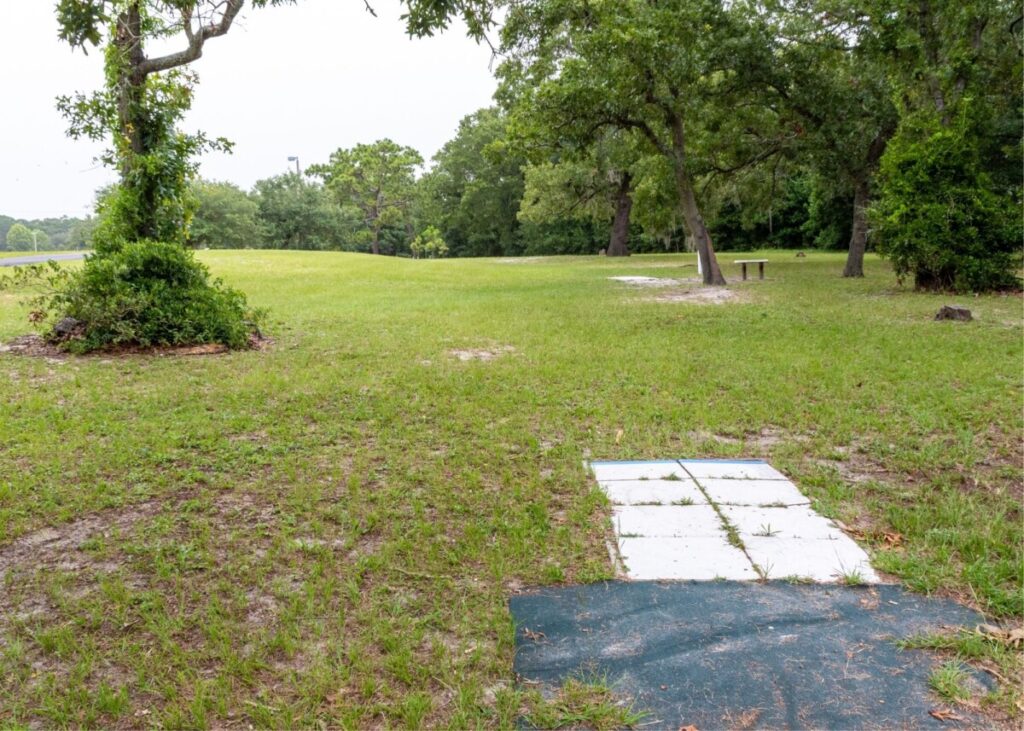
What Happens If You Foot Fault?
According to the PDGA rules, a player who commits a foot fault will receive a one-stroke penalty. A foot fault penalty will usually only be called while in group play by another person on the card.
So, for there to be a called foot fault, a member of the group must declare a violation immediately.
For the call to be confirmed, another group member would have to second the call. If a second player seconds the foot fault call, then the penalty will be official.
Disc Golf Foot Fault Penalty
For the rule to be effective, there has to be a penalty behind it. If a foot fault is called and seconded, there will be a one-stroke penalty applied to that hole.
The penalty for a foot fault has undergone some change throughout the years to make the violation more severe.
Players might have called a foot fault on themselves, or intentionally foot fault if they felt their shot was poor.
At that time, a foot fault only resulted in a warning and a re-throw.
With today’s rules, this is much less common because of the one-stroke penalty.
Of course, the player who committed the foot fault can call a foot fault on themselves, but this will still need to be confirmed by a second person to make it official.
What is a Stance Violation?
A stance violation is a correct term used in the official rules of disc golf for a foot fault. Most people are more familiar with the term “foot fault” because of its use in other sports.
A stance violation is a more descriptive term in disc golf to cover this rule.
The official rules refer to a stance violation because you can commit a violation with any part of the body.
A foot fault can be called for a hand being placed outside of the designated throwing area, or “lie” (more on this later), if the hand is also being used to support the body.
So, remember that any part of the body that is being used to support yourself, that is also outside of the designated area at the time of release can be a stance violation.
However, throughout this article, I’ll still refer to it as “foot fault”.
Jargon Buster: Important Disc Golf Terms to Know
Supporting Point
A supporting point in disc golf refers to any part of the anatomy that is used to support the player’s body weight.
The PDGA official rules describe a supporting point this way:
“A supporting point is any part of the player’s body that is, at the time of release, in contact with the playing surface or any other object that provides support. The player is allowed to have a supporting point outside the teeing area before or after, but not at, the moment the disc is released.”
Lie
The lie is described as the place on the playing surface where the player takes a stance to throw.
For example, the lie for the first throw on a hole would be the teeing area.
Drop Zone
A drop zone is by definition a lie too. But in this case, the drop zone is a designated area on the course that is used to make a throw under certain conditions.
A drop zone will usually be marked by the Director on a course and only used for certain throws.
For example, if your disc went out of bounds when throwing onto an island hole. (An island hole is when a disc golf basket is located on an island)
Mini Marker Disc
A mini marker is a small circular disc that’s not used for play but only used for making a lie. The marker disc is placed on the playing surface where the original disc landed.
Mini marker discs can be made from plastic, metal, or even wood.
Line of Play
The line of play is an imaginary line on the playing surface extending from the center of the target through and beyond the center of the marker disc.
Examples of Disc Golf Foot Faults
Every foot fault in disc golf is not created equal. The rules of what makes a foot fault, or a stance violation can be slightly different depending on where you’re throwing the disc from on the course.
Below are explanations and examples of a foot fault from different areas on the disc golf course.
Tee Box Foot Fault
Every hole begins with players throwing from the tee. A tee can be different depending on the course.
Most tees will include a visible rectangular boundary. Some courses won’t have this visible boundary.
If the boundary isn’t visible the rule is that there is an imaginary rectangular area that extends 3 meters or just under 10 feet behind the front tee line.
If there is a visible boundary, the imaginary 3-meter rule will not apply and the visible tee boundary will apply only.
Disc golf rules state that the player must have at least one supporting point inside of the boundary at the time of release.
You’re allowed to overhang the boundary, only as long as there is no supporting point outside of the boundary at the time of release.
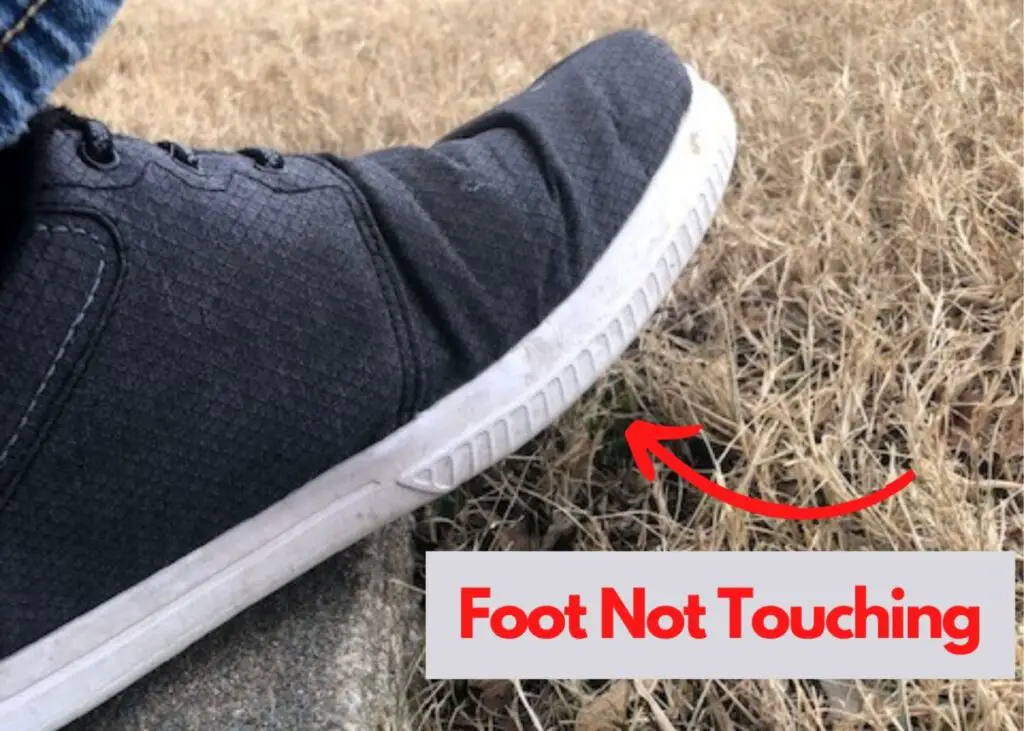
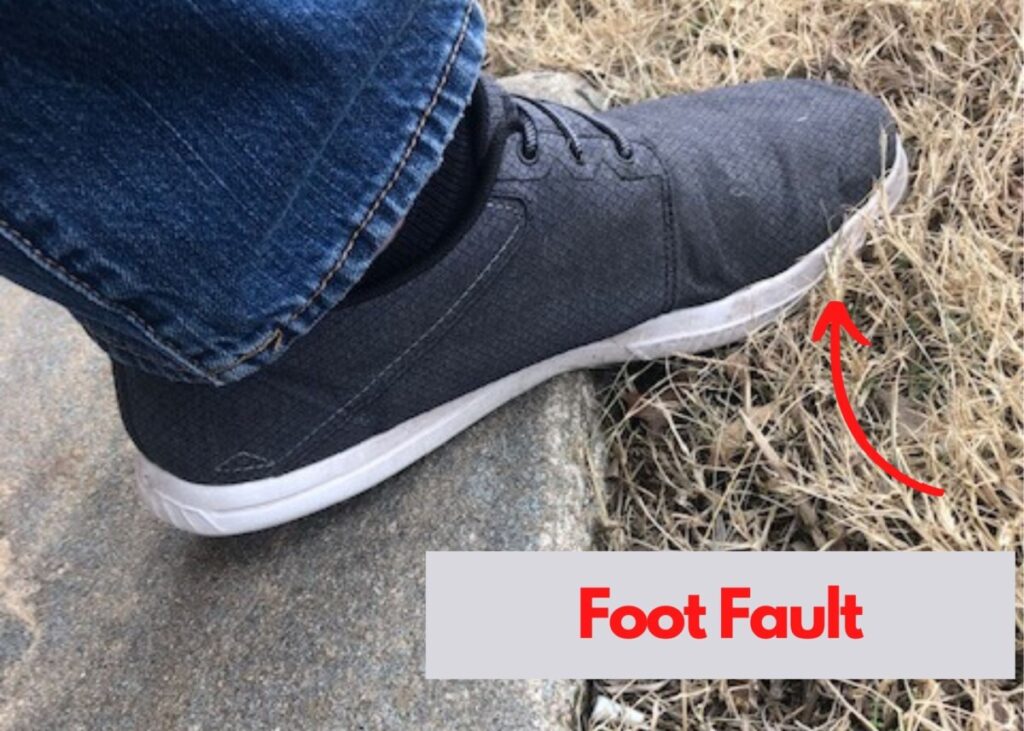
Fairway Foot Fault
When throwing from a fairway, there are slightly different foot fault rules when there is no tee available to throw from.
This is where throwing from your lie comes into play. As I explained earlier, the lie is the area on the playing surface that a player uses to throw the disc from.
The back edge of the disc is where the front edge of the lie begins. The lie uses an imaginary rectangle that measures 11.8″ x 7.8″ (or 30cm x 20cm).
It’s much easier to imagine a piece of 11″ x 8″ printing paper, centered behind the back edge of the disc.
Additionally, players will also use the mini marker disc to mark the boundary of the lie. The mini marker disc can be placed at the front edge of the disc, or the back edge of the disc.
Whichever you choose is where the lie begins with the imaginary 30cm x 20cm rectangle.
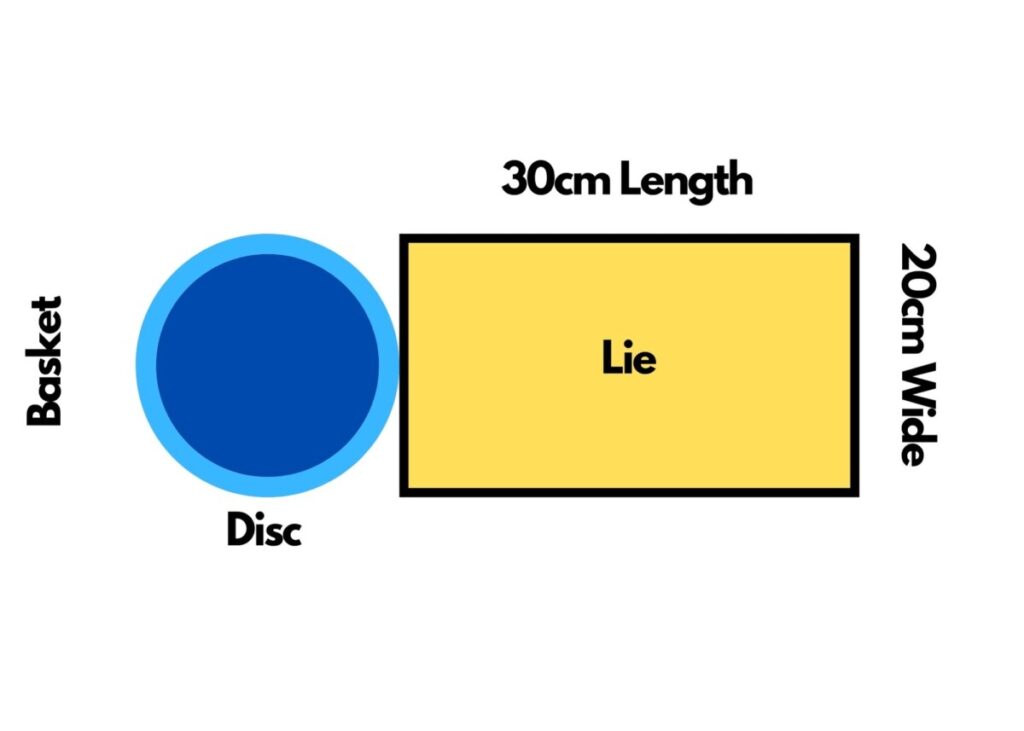
Can You Throw Behind Your Lie?
It’s perfectly legal to throw behind the front line of the lie. You will need to have at least one supporting point of contact within the lie at the point of release.
No other supporting points can be outside of the lie.
Keep in mind, you’re not able to run up to the lie to throw. Also, when throwing your feet can’t cross the front of the lie.
Putting Foot Fault
Once a player reaches the putting green, foot fault rules will change yet again. This will only affect a player that is within 10 meters of the basket.
If you’re still more than 10 meters away from the basket, the fairway rules will apply.
When you’re within this 10-meter boundary, no supporting point can touch in front of the lie until the player has “full control of balance”.
This can be a little bit of a gray area when it comes to determining what is or isn’t a foot fault.
Full control of balance is an important difference because throwing from the tee or the fairway, a player can step over the front of the lie after the disc has been released, regardless of whether they’ve established balance or not.
When putting, a player can only step in front of the lie after full control of balance has been established.
What this does is prevent a player from using a “falling putt”. A falling putt is when a player steps through the front of the lie as they putt.
It’s considered a falling putt even if the disc has been released and you have to use the area in front of the lie to gain balance.
What is a Jump Putt Foot Fault?
A jump putt is when a player jumps to create momentum for a putt that is outside of the 10-meter circle.
There are some potential problems with using a jump putt when it comes to a foot fault or stance violation.
First, you still need to have one supporting point in contact with the lie until the disc is released.
If you’ve released the disc before your feet leave the ground, a jump putt would be legal.
If you’re inside of the 10-meter circle, jumping forward would cause you to cross the front of the lie. At this point, you wouldn’t have full control of balance before crossing the front of the lie.
This is why using a jump putt from inside the 10-meter circle is basically impossible to do without a stance violation.
Out of Bounds Foot Fault
Playing near the out-of-bounds area brings with it the risk of a foot fault too. Similar to throwing from the tee, no part of the body used as a supporting point can be in an out-of-bounds area.
You can overhang into an out-of-bounds area when throwing, just as long as no part of your body is being used as a supporting point and touching the out-of-bounds.
Depending on how close your disc lands to the out-of-bounds line, this can make a shot difficult while still trying to avoid a foot fault.
In this case, the rules do allow for a one-meter relief from an out-of-bounds area.
Drop Zone Foot Fault
A drop zone can be played several ways, depending on how it’s marked on a particular course. This can affect what rules are in effect for a foot fault.
If the drop zone is only marked with a line, the area can be played like a tee shot. Remember, this means that there is an imaginary rectangular area about 3 meters deep behind the line to throw from.
If the drop zone is marked with a round marker disc or disc-like object, then the shot would be thrown like a fairway shot.
In this case, the foot fault rule would be subject to the 30cm x 20cm rectangle area directly behind the back edge of the marker.
How To Avoid a Foot Fault
Avoiding a foot fault will come down to a good understanding of the rules, footwork, and practice.
Here are the main points to remember to avoid taking a stance violation or foot fault penalty in the future.
1. Understand What a Supporting Point is and Isn’t
There is no better way to get called on a foot fault than to have a part of the body acting as a supporting point outside of the throwing area.
Understand that a supporting point can mean other things than just your foot. For example, a person crouching down on a fairway lie can’t reach forward past the mini marker disc for support, even if your feet are planted within the lie.
However, any part of your body can be overhanging or extending out of the tee or lie at the time of release. Just so long as they aren’t being used as a supporting point.
2. Know What a Disc Golf “Lie” is
Determining what the lie is on a fairway shot can be difficult for beginners, and lead to costly one-stroke penalties.
The reason why this can be confusing is that if using a mini marker disc, you have the option of placing that disc at the front edge of the throwing disc, or the back edge of the disc.
Depending on which spot you place the marker disc, this means that the lie can begin at two possible lines. The lie will include the 30cm x 20cm rectangle that starts from one of these two points.
3. Don’t Step Out of Bounds
You might be thinking, yeah don’t step out of bounds, duh. But, when dealing with a fairway shot and the small lie, it can be easy to forget about the out-of-bounds line when throwing.
Stepping in the out-of-bounds area before the release will result in a foot fault every time.
Luckily, as I explained earlier, a player is given a one-meter relief from the out-of-bounds line if your disc happens to land very close to the out-of-bounds line.
4. Establish Balance on Putts
Establishing balance can take a little bit of practice. If you’re outside of the 10-meter circle, no problem. But, inside of the 10-meter circle is when establish of balance takes effect.
It can be difficult to create the momentum required behind the throw when standing in one spot.
It’s tempting to try to putt and hover over the line until the disc hits the chains. But, even doing this can result in a foot fault.
This is because you haven’t established balance before stepping over the line.
It’s better to make a habit of throwing from the lie and establishing balance before ever stepping across the line. Even if the disc has already hit the basket.
Summary | Disc Golf Foot Faults
A foot fault in disc golf isn’t called as much as you think. This is because the penalty must be initiated and then seconded by people in the group.
In my experience, only repeated violations or egregious violations will ever be called and seconded in a group of players.
But the best defense is a good offense, and that starts with knowing the rules and adding practice so the next time you hit that amazing shot it won’t be nullified by a silly foot fault or stance violation.
